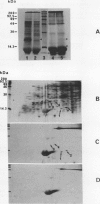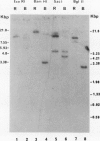Abstract
To study long-lived mRNAs stored in radish (Raphanus sativus) seed, we have selected clones from a dry seed cDNA library by differential screening. One of these clones, p8B6, whose mRNAs are abundant in the dry seed, was characterized. This clone hybridizes to an RNA class of approximately 600 nucleotides whose accumulation begins during the desiccation phase, reaches its maximum level in the dry seed, and is no longer detectable in 12 hour old seedlings. mRNAs hybrid-selected by p8B6 encode four polypeptides, but only two are compatible with the size class of RNAs detected by Northern analysis. Three of them have previously been identified as major `early germination' polypeptides, and their synthesis has been shown to be induced prematurely in immature embryos by a desiccation treatment. The protein deduced from the p8B6 nucleotide sequence is 9 kilodaltons in size, highly hydrophilic, rich in Gly and Glu, and contains no Cys, Trp, and lie. The amino acid sequence shares good homology with that of two recently described seed proteins: a cotton late embryogenesis abundant protein and the wheat early methionine-labeled protein. Southern blot analysis suggests that the p8B6 sequence belongs to a very small gene family. The exact function of the product encoded by p8B6 remains to be determined.
Full text
PDF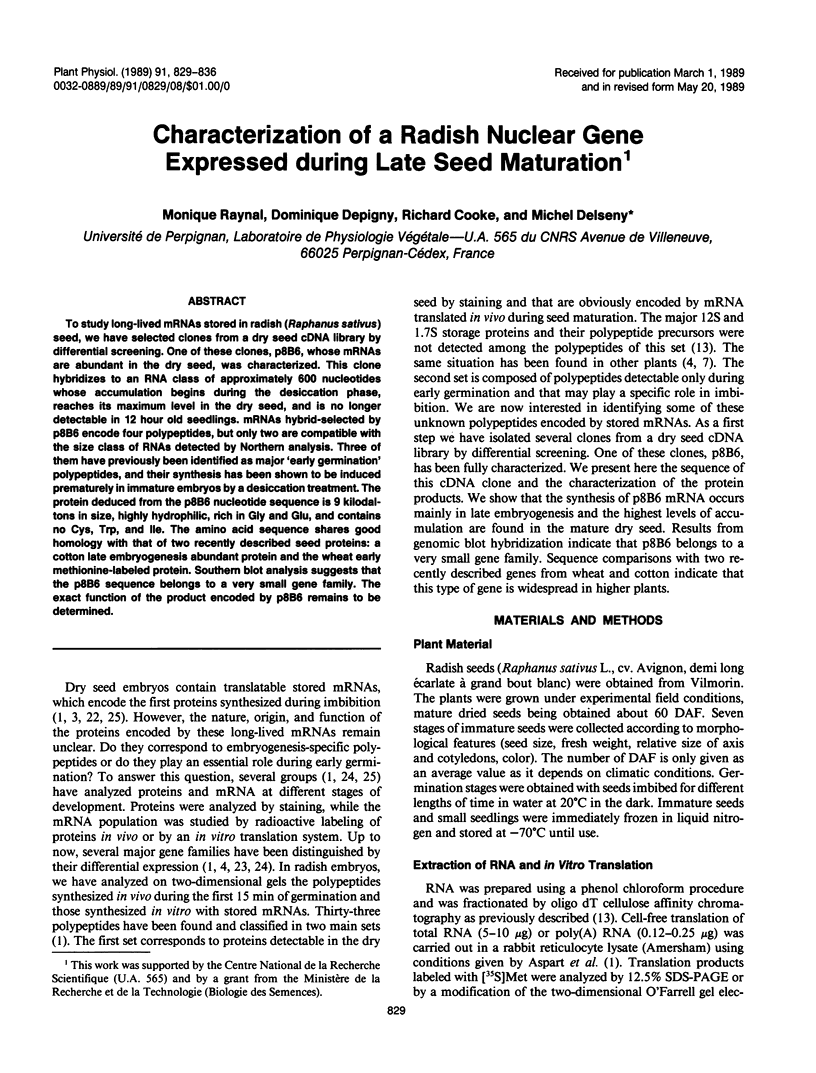
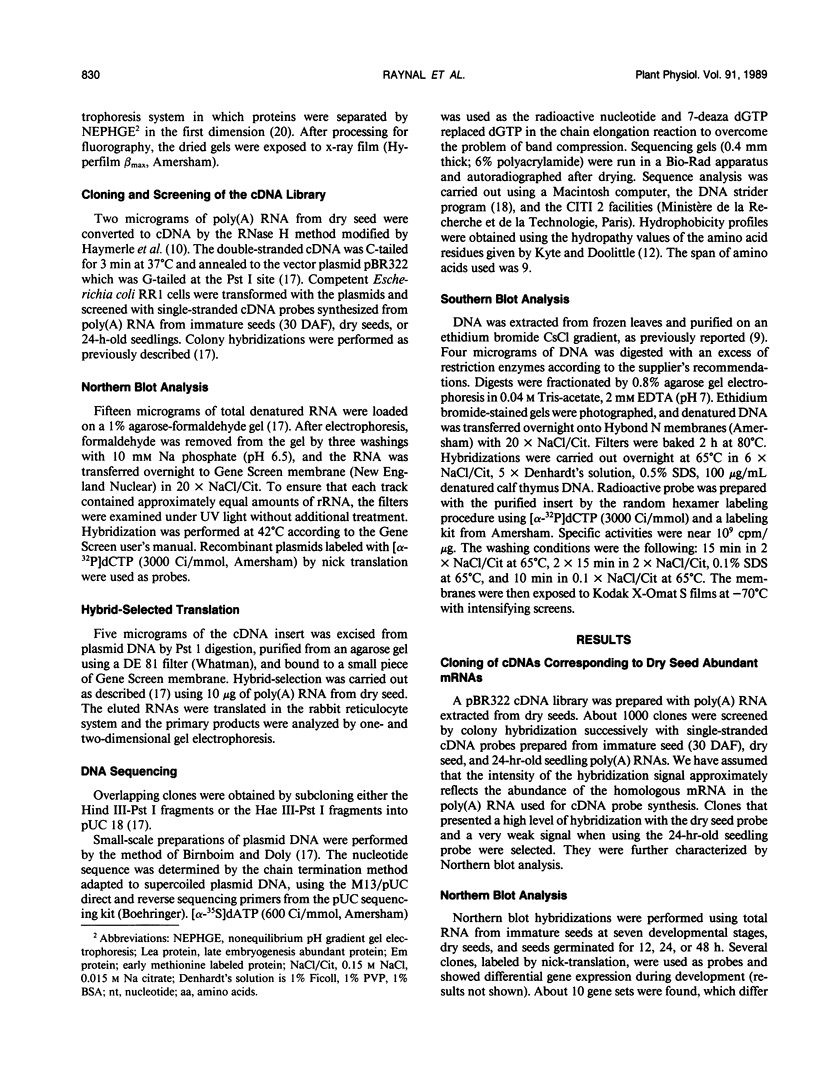
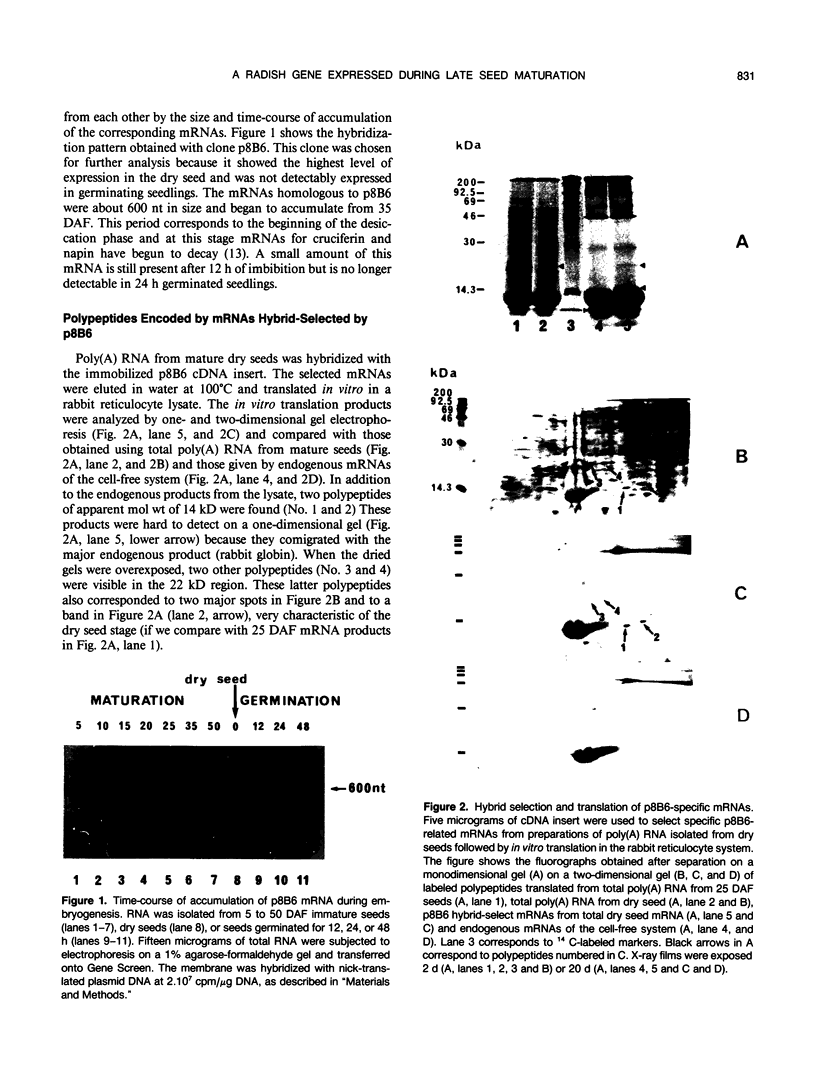
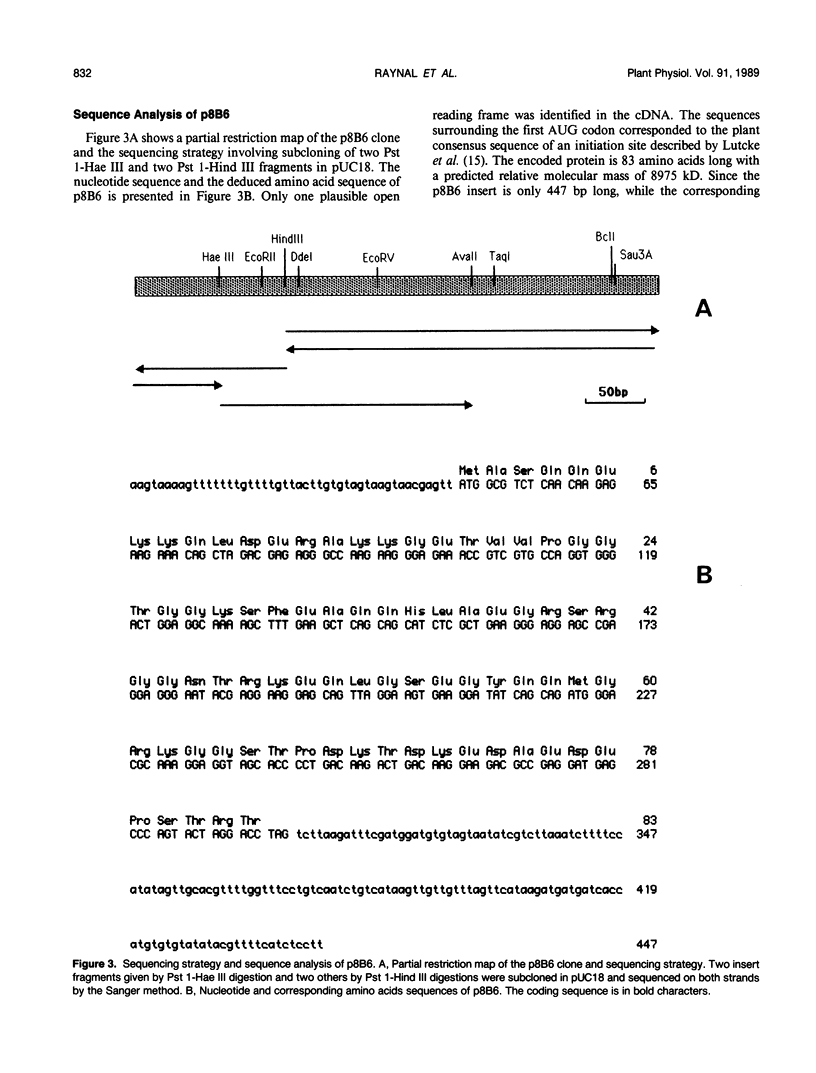
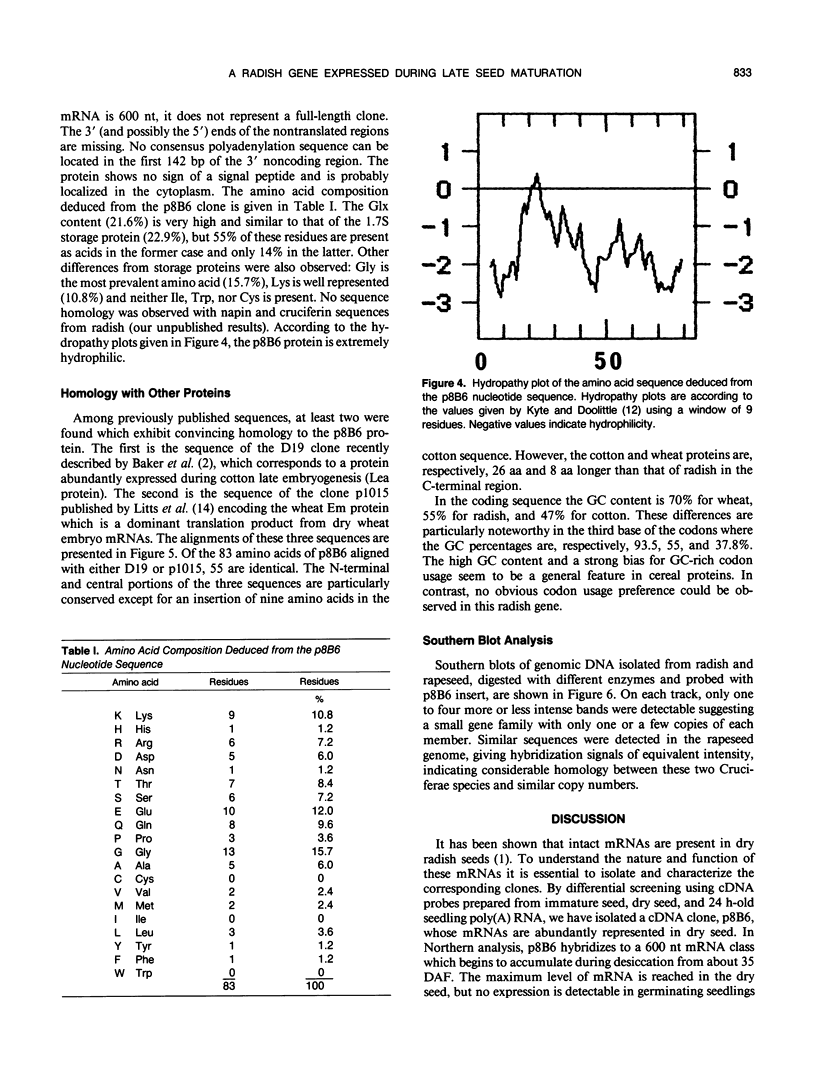
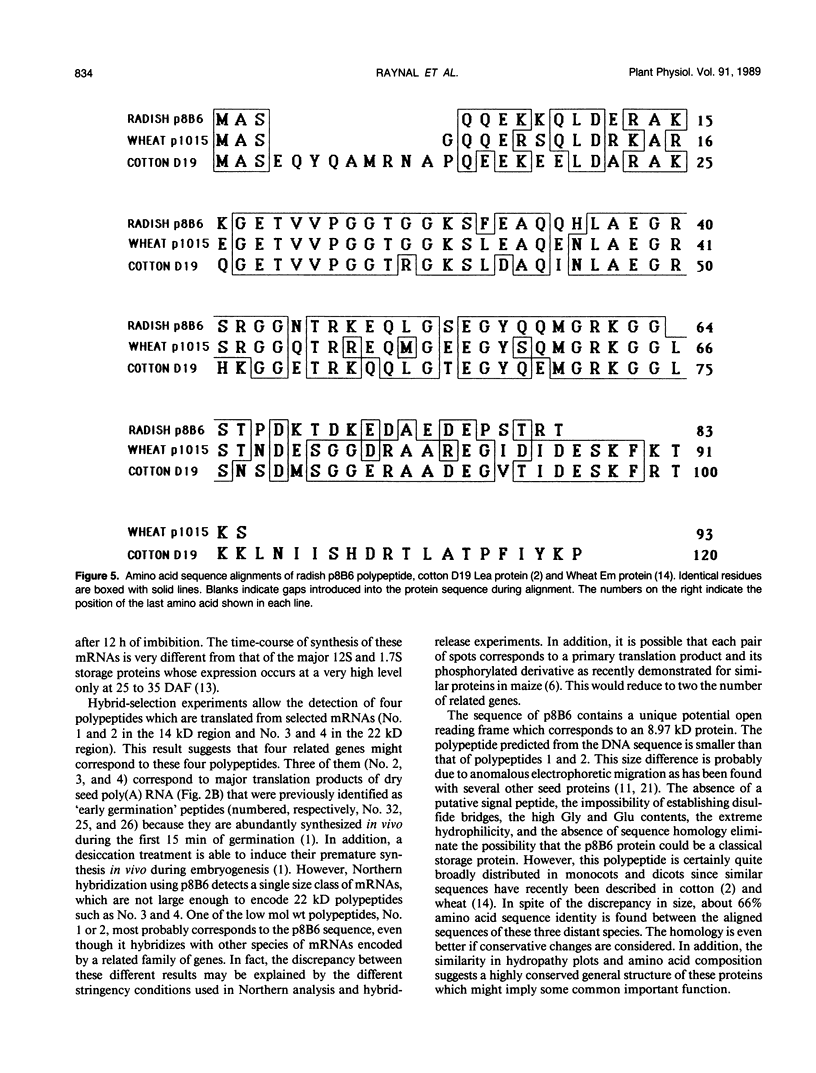
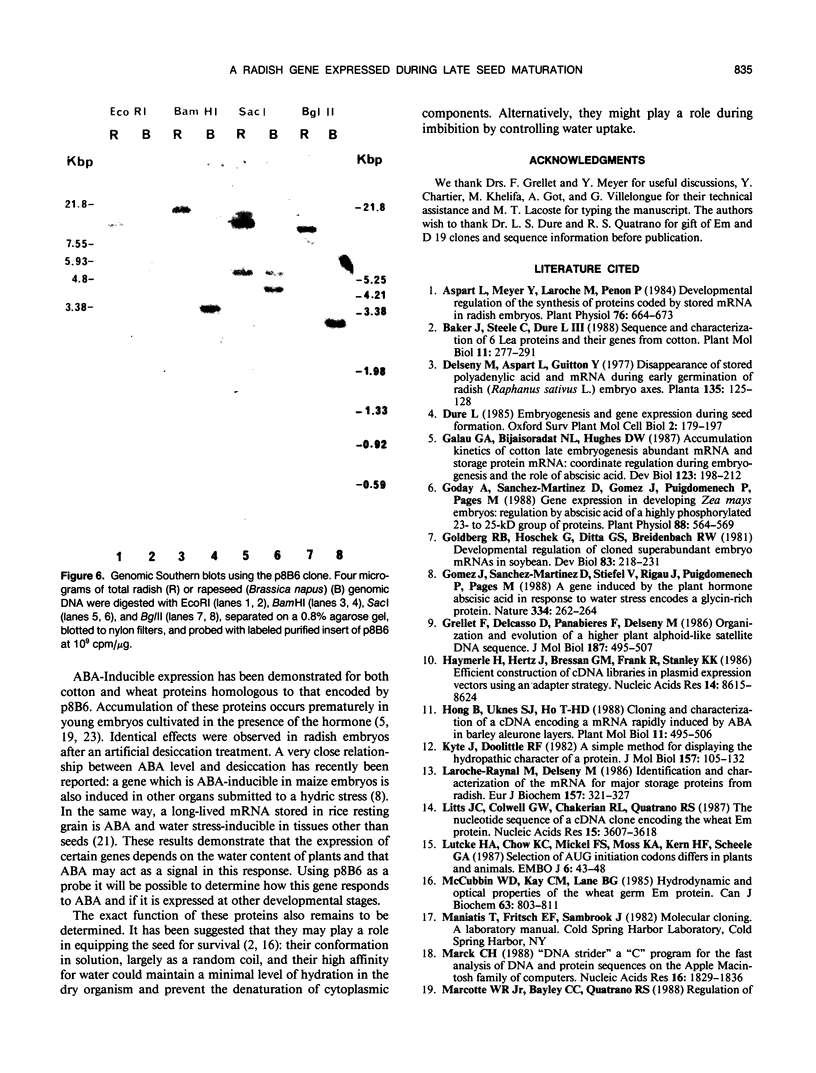

Images in this article
Selected References
These references are in PubMed. This may not be the complete list of references from this article.
- Aspart L., Meyer Y., Laroche M., Penon P. Developmental regulation of the synthesis of proteins encoded by stored mRNA in radish embryos. Plant Physiol. 1984 Nov;76(3):664–673. doi: 10.1104/pp.76.3.664. [DOI] [PMC free article] [PubMed] [Google Scholar]
- Galau G. A., Bijaisoradat N., Hughes D. W. Accumulation kinetics of cotton late embryogenesis-abundant mRNAs and storage protein mRNAs: coordinate regulation during embryogenesis and the role of abscisic acid. Dev Biol. 1987 Sep;123(1):198–212. doi: 10.1016/0012-1606(87)90442-8. [DOI] [PubMed] [Google Scholar]
- Goday A., Sánchez-Martínez D., Gómez J., Puigdomènech P., Pagès M. Gene Expression in Developing Zea mays Embryos: Regulation by Abscisic Acid of a Highly Phosphorylated 23- to 25-kD Group of Proteins. Plant Physiol. 1988 Nov;88(3):564–569. doi: 10.1104/pp.88.3.564. [DOI] [PMC free article] [PubMed] [Google Scholar]
- Goldberg R. B., Hoschek G., Ditta G. S., Breidenbach R. W. Developmental regulation of cloned superabundant embryo mRNAs in soybean. Dev Biol. 1981 Apr 30;83(2):218–231. doi: 10.1016/0012-1606(81)90468-1. [DOI] [PubMed] [Google Scholar]
- Grellet F., Delcasso D., Panabieres F., Delseny M. Organization and evolution of a higher plant alphoid-like satellite DNA sequence. J Mol Biol. 1986 Feb 20;187(4):495–507. doi: 10.1016/0022-2836(86)90329-3. [DOI] [PubMed] [Google Scholar]
- Gómez J., Sánchez-Martínez D., Stiefel V., Rigau J., Puigdomènech P., Pagès M. A gene induced by the plant hormone abscisic acid in response to water stress encodes a glycine-rich protein. Nature. 1988 Jul 21;334(6179):262–264. doi: 10.1038/334262a0. [DOI] [PubMed] [Google Scholar]
- Haymerle H., Herz J., Bressan G. M., Frank R., Stanley K. K. Efficient construction of cDNA libraries in plasmid expression vectors using an adaptor strategy. Nucleic Acids Res. 1986 Nov 11;14(21):8615–8624. doi: 10.1093/nar/14.21.8615. [DOI] [PMC free article] [PubMed] [Google Scholar]
- Kyte J., Doolittle R. F. A simple method for displaying the hydropathic character of a protein. J Mol Biol. 1982 May 5;157(1):105–132. doi: 10.1016/0022-2836(82)90515-0. [DOI] [PubMed] [Google Scholar]
- Laroche-Raynal M., Delseny M. Identification and characterization of the mRNA for major storage proteins from radish. Eur J Biochem. 1986 Jun 2;157(2):321–327. doi: 10.1111/j.1432-1033.1986.tb09671.x. [DOI] [PubMed] [Google Scholar]
- Litts J. C., Colwell G. W., Chakerian R. L., Quatrano R. S. The nucleotide sequence of a cDNA clone encoding the wheat Em protein. Nucleic Acids Res. 1987 Apr 24;15(8):3607–3618. doi: 10.1093/nar/15.8.3607. [DOI] [PMC free article] [PubMed] [Google Scholar]
- Lütcke H. A., Chow K. C., Mickel F. S., Moss K. A., Kern H. F., Scheele G. A. Selection of AUG initiation codons differs in plants and animals. EMBO J. 1987 Jan;6(1):43–48. doi: 10.1002/j.1460-2075.1987.tb04716.x. [DOI] [PMC free article] [PubMed] [Google Scholar]
- Marck C. 'DNA Strider': a 'C' program for the fast analysis of DNA and protein sequences on the Apple Macintosh family of computers. Nucleic Acids Res. 1988 Mar 11;16(5):1829–1836. doi: 10.1093/nar/16.5.1829. [DOI] [PMC free article] [PubMed] [Google Scholar]
- Meyer Y., Grosset J., Chartier Y., Cleyet-Marel J. C. Preparation by two-dimensional electrophoresis of proteins for antibody production: antibodies against proteins whose synthesis is reduced by auxin in tobacco mesophyll protoplasts. Electrophoresis. 1988 Nov;9(11):704–712. doi: 10.1002/elps.1150091105. [DOI] [PubMed] [Google Scholar]
- Mundy J., Chua N. H. Abscisic acid and water-stress induce the expression of a novel rice gene. EMBO J. 1988 Aug;7(8):2279–2286. doi: 10.1002/j.1460-2075.1988.tb03070.x. [DOI] [PMC free article] [PubMed] [Google Scholar]
- Sánchez-Martínez D., Puigdomènech P., Pagès M. Regulation of Gene Expression in Developing Zea mays Embryos: Protein Synthesis during Embryogenesis and Early Germination of Maize. Plant Physiol. 1986 Oct;82(2):543–549. doi: 10.1104/pp.82.2.543. [DOI] [PMC free article] [PubMed] [Google Scholar]
- Thompson E. W., Lane B. G. Relation of protein synthesis in imbibing wheat embryos to the cell-free translational capacities of bulk mRNA from dry and imbibing embryos. J Biol Chem. 1980 Jun 25;255(12):5965–5970. [PubMed] [Google Scholar]




